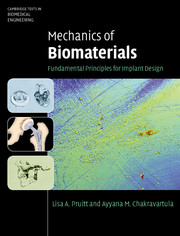Book contents
Epilogue
Published online by Cambridge University Press: 05 June 2012
Summary
Mechanics of Biomaterials: Fundamental Principles for Implant Design provides the requisite engineering principles needed for the design of load-bearing medical implants with the intention of successfully employing natural or synthetic materials to restore structural function in biological systems. One challenge in the medical device field is the multifactorial nature of the design process. Numerous elements affect device performance, including clinical variables, structural requirements, implant design, materials selection, manufacturing, and sterilization processes. The crucial requirement of any medical device is that it is biocompatible; the implant must restore function without adverse reaction or chronic inflammatory response in the body. In this respect, choice of materials used in the implant is key to the device integrity.
Moreover, the structural requirements of the implant are determined through an assessment of the expected physiological stresses that vary depending upon the patient's anatomy, weight, and physical activity. Analyses of these stresses are key in making certain that the selected material offers the appropriate mechanical properties such as requisite elastic modulus and yield stress, as well as resistance to creep, fracture, fatigue, and wear. This book addresses the complexities that are encountered in physiological loading such as three-dimensional stress states; the complex interplay of dynamic loading, contact mechanics, viscoelastic deformation, and rupture; as well as the combined effects of environmental degradation of the materials owing to biological attack, aqueous environment, and sterilization method employed.
- Type
- Chapter
- Information
- Mechanics of BiomaterialsFundamental Principles for Implant Design, pp. 595 - 596Publisher: Cambridge University PressPrint publication year: 2011



